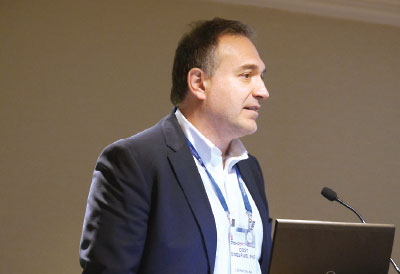Affective Psychosis Common Among First-Episode Patients
Abstract
Affective psychosis is significantly prevalent among first-episode psychosis patients but there is a dearth of research on this population and a need for development of standardized treatment guidelines.
Clinicians should be alert to the prevalence of individuals with affective psychosis in first-episode psychosis clinics. The condition is characterized by mania and possibly presenting as a precursor to bipolar disorder, said Dost Ongur, M.D., Ph.D., in a keynote address at the Early Psychosis Pre-Conference at APA’s IPS: The Mental Health Services Conference. The IPS was held last month in New York.

Dost Ongur, M.D., Ph.D., says a major unresolved question in treatment of affective psychosis in first-episode psychosis clinics is whether first-episode patients with affective psychosis should be maintained on a mood stabilizer.
Ongur, the director of the Schizophrenia and Bipolar Disorder Research Program and chief of the Psychotic Disorders Division at McLean Hospital, said that more than 40% of early psychosis patients at McLean have affective psychosis.
“These people belong in our early psychosis treatment services,” said Ongur, who is also editor of JAMA Psychiatry. “If you can recognize people with affective psychosis, you can do something about a potentially underserved population. Many of their needs are similar to those with nonaffective psychosis.”
Ongur said there is a critical need for research on this population and development of standardized treatment guidelines.
He noted that there is no equivalent of the Recovery After Initial Schizophrenia Episode (RAISE) study on early treatment of nonaffective psychosis. “Evidence for early intervention is sparse compared with nonaffective psychosis, but there is research demonstrating that the long-term trajectory can be altered with good treatment,” he said.
RAISE was a research project funded by the National Institute of Mental Health (NIMH) that provided much of the foundation for the effectiveness of coordinated specialty care of people with first-episode psychosis.
Ongur said a first episode of affective psychosis with mania may be the first presentation of bipolar disorder, with typically a long delay between onset of illness and the establishment of a bipolar disorder diagnosis. This delay is equivalent to the duration of untreated nonaffective psychosis; longer duration has been repeatedly shown to negatively impact long-term outcome in nonaffective psychosis, he said.
“We need to change that,” Ongur said. “People are often going to the doctor for years, and bipolar disorder is never mentioned.”
Characteristics of first-episode psychosis with mania include euphoria, reduced need for sleep, grandiosity, and racing thoughts. These are accompanied by a progressive loss of insight. “However, these symptoms may be frequently misinterpreted in the context of psychosis,” Ongur said. “Some patients are diagnosed with schizoaffective disorder when the psychosis persists for a significant period outside of mood episodes or with schizophrenia when mood episodes are isolated and not clinically significant.”
Ongur especially emphasized that extreme manic behavior often causes a great deal of damage to social relationships. A return to recovery and full functioning very often entail working through guilt and shame associated with behavior during the manic episode and making an effort to rebuild relationships.
Patients typically respond to treatment with a combination of the mood stabilizer lithium and an antipsychotic. There is also an important role for psychoeducation, cognitive-behavioral therapy, interpersonal and social rhythm therapy (IPSRT), and family focused therapy. (IPSRT is designed to help people improve their moods by understanding and working with their biological and social rhythms.)
Ongur said antipsychotic medication may be tapered six to 12 months following the first episode, but a major unresolved clinical and research question is how long patients should be maintained on mood stabilizer.
“The experience at McLean suggests that many individuals can tolerate tapering to lamotrigine monotherapy, but that all pharmacotherapy should not be discontinued,” Ongur said.
Ongur’s presentation was the second keynote address at the one-day conference sponsored by APA and SMI Adviser in partnership with NIMH, the Substance Abuse and Mental Health Services Administration, and the Psychosis-Risk and Early Psychosis Program Network. SMI Adviser is APA’s Clinical Support System for Serious Mental Illness, established with a grant from SAMHSA.
The conference brought together more than 350 clinicians and researchers from around the country involved in early psychosis treatment. “When we ask APA members what areas in which they feel they need more education, management of early psychosis is near the top of the list,” said APA Director of Education Tristan Gorrindo, M.D. “Programs such as this early psychosis conference and APA’s SMI Adviser initiative help front-line clinicians implement evidence-based care for those with early psychosis.” ■
More information on SMI Adviser and its new app is posted here.



